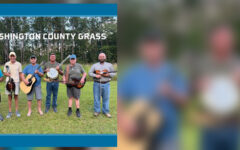
 The Deer Creek Boys may appear to be 2016’s overnight success story, based on the likely success of their Mountain Fever debut project, What Goes Up, but this energetic and youthful group has been together now going on 18 years. And despite periods of relative inactivity, they have retained the core structure of the band intact all that time.
The Deer Creek Boys may appear to be 2016’s overnight success story, based on the likely success of their Mountain Fever debut project, What Goes Up, but this energetic and youthful group has been together now going on 18 years. And despite periods of relative inactivity, they have retained the core structure of the band intact all that time.
Things got going in 1999 when two brothers, Jason and Justin Tomlin, started a band with their childhood best friend, Cason Ogden in Amherst, VA, just north of Lynchburg. Justin and Cason were in middle school, and Jason in elementary. Despite their youth, these three were serious about bluegrass music, Justin on guitar, Jason on bass, and Cason on mandolin. By the time they were in high school, a banjo player was added and the boys started generating some attention in central and southwestern Virginia, both for their aggressive performance style and their strong original material.
In 2007 the Deer Creek Boys had won the Bluegrass Band competition at the Old Fiddlers Convention in Galax with David Carroll on banjo. But in 2009, Junior Sisk hired Jason to travel with him and Rambler’s Choice, initially on mandolin and later bass, and Justin and Cason were left behind. A few years later, Justin accepted the guitar gig with Nothin’ Fancy.
But both Tomlin boys left their touring bluegrass jobs in 2014 to reunite with Ogden and kick start their passion for the Deer Creek Boys. By now, of course, the boys were grown men with family responsibilities, but also with greatly enhanced skills as performers. Andy Lowe from North Carolina came aboard on banjo, and Mountain Fever quickly signed them to record for the label.
 The result is a winning release that exemplifies what some are calling mashgrass, a dynamic, in-your-face approach to the music with a tenacious commitment to the groove and a convincing vocal presentation. In many ways their sound compares to other successful Virginia bands like Lost and Found or Lonesome River Band (in its earlier days) showing the minimalist power of the four piece band in a time when six pickers on stage is common.
The result is a winning release that exemplifies what some are calling mashgrass, a dynamic, in-your-face approach to the music with a tenacious commitment to the groove and a convincing vocal presentation. In many ways their sound compares to other successful Virginia bands like Lost and Found or Lonesome River Band (in its earlier days) showing the minimalist power of the four piece band in a time when six pickers on stage is common.
In the end, though, it’s the quality of the songwriting that makes What Goes Up a keeper, most of it written by the Tomlin brothers, with a couple of grassed-up country covers thrown in.
If you’ve ever escaped from a toxic relationship, and haven’t we all, the opening number So Good To Be Gone is liable to stir up some emotions. In it the singer rejoices in his freedom from pain, and revels in being removed from a bad situation. The youthful energy of this bunch grabs you right away as the band pounds out the rhythm, with Lowe channeling Ron Stewart on the banjo. This one, written by Justin, sounds like a hit to me.
Another of his, Kristine, feels like it could be the prequel to that first. A sad love song, it tells of a man in a bad match with a woman he can’t please no matter how he tries. It has a very tender, vulnerable message, and I can well imagine the joyous enthusiasm of So Good To Be Gone as a response to Kristine’s unfaithfulness.
How A Cowgirl Says Goodbye, the album’s first single, was a hit for Tracy Lawrence around the time these boys were first learning to play, and it converts very smoothly to a bluegrass version. As does Dallas, which Alan Jackson took to #1 in ’91. Justin sings them both assuredly, showing his comfort in both straightahead grass and contemporary country.
Jason takes the lead for a number of his songs. Her Memory’s Like The Wind is an acoustic country number of lost love, Gypsy Soul, about a squandered affair with a free spirit who couldn’t be contained, and This One Life To Live which closes the project, the retelling of a dream where he witnesses the reaction of friends and family at his graveside.
Tater also sings a mashed-up version of the Gospel classic, Little White Church. We’ve all heard this one countless times, but you’ve not likely heard it like this. Their arrangement speeds up the song, with a extra driving beat, and some unexpected flatted 7ths in the melody (and the mandolin backup). But it works and really gets the spirit flowing.
Ogden contributes a song to What Goes Up, a Civil War piece called Grey Ghost. Jason sings lead on this minor-keyed ditty of death and murder. Justin’s Some Kind Of Beautiful, another acoustic country composition, explains how the eyes of love makes your beloved look beautiful no matter how fixed up she may be.
The guys also took the iconic Robert Service poem, The Cremation Of Sam McGee, and set it to music. The rugged story of the Yukon territories makes a fine bluegrass song, with sparse accompaniment swelling to a full band by the end.
Kudos to Andy Lowe for sticking to the driving roll style banjo on all but the ballads on the album. It serves as the perfect rhythmic ballast for the Deer Creek originals, which often cycle quickly through chord changes, to have the solid banjo as a constant. I’ve admired his playing for some time but he really shows himself to be a great band player here.
All of the Boys are strong pickers, playing perfectly appropriate accompaniment throughout, before letting loose on their solos. Jeff Partin on reso-guitar and Molly Cherryholmes on fiddle supply able guest appearances as well.
Look for What Goes Up to be the breakout release from this talented outfit. Anyone who appreciates the unbridled enthusiasm of young artists will find much to enjoy in this exuberant display of bluegrass talent.
It’s a good’n.







